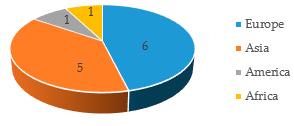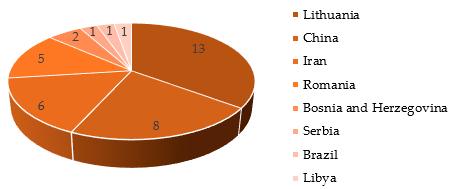SolutionModelsBasedonSymmetricand AsymmetricInformation
EdmundasKazimierasZavadskas 1,2 ,ZenonasTurskis 1,2 andJurgitaAntucheviciene 1,*
1 DepartmentofConstructionManagementandRealEstate,VilniusGediminasTechnicalUniversity, Sauletekioal.11,LT-10223Vilnius,Lithuania;edmundas.zavadskas@vgtu.lt(E.K.Z.); zenonas.turskis@vgtu.lt(Z.T.)
2 LaboratoryofOperationsResearch,InstituteofSustainableConstruction, VilniusGediminasTechnicalUniversity,Sauletekioal.11,LT-10223Vilnius,Lithuania
* Correspondence:jurgita.antucheviciene@vgtu.lt;Tel.: +370-5-274-5233
Received:2April2019;Accepted:2April2019;Published:5April2019
Abstract: ThisSpecialIssuecoverssymmetryandasymmetryphenomenaoccurringinreal-life problems.Weinvitedauthorstosubmittheirtheoreticalorexperimentalresearchpresenting engineeringandeconomicproblemsolutionmodelsdealingwiththesymmetryorasymmetryof differenttypesofinformation.Theissuegainedinterestintheresearchcommunityandreceivedmany submissions.Afterrigorousscientificevaluationbyeditorsandreviewers,ninepaperswereaccepted andpublished.Theauthorsproposeddifferentsolutionmodelsasintegratedtoolstofindabalance betweenthecomponentsofsustainableglobaldevelopment,i.e.,tofindasymmetryaxisconcerning goals,risks,andconstraintstocopewiththecomplicatedproblems.Wehopethatasummaryofthe SpecialIssueasprovidedinthiseditorialwillencourageadetailedanalysisofthepapers.

Keywords: hybridproblemsolutionmodels;multiple-criteriadecision-making(MCDM);hybrid MCDM;criteriaweightassessment;fuzzysets;roughsets;Z-numbers;neutrosophicnumbers; Bonferronimean(BM)operator;engineeringproblems;economicdecisions
1.Introduction
Anintegralpartofcontemporaryhumanactivitiesischoosingthemostefficientsolutionsand justifyingtheselectedalternativesandjudgmentsofselectedjustifyingprocedures.Allobjective measurementinvolvessubjectivejudgments.Firstly,developersofplansdecidewhichproblems mustbesolvedandwhichnot.Modeldevelopmentconsistsofthedefinitionofmodelobjectives, conceptualizationoftheproblem,translationintoacomputationalmodel,andmodeltesting,revision, andapplication.Theory,priorknowledge,andotherinputsdeterminewhichfeaturesofagivenprocess tohighlightandwhichtoleaveoutunderagivensetofconditionsthatwilldictatethespecificationof themodel.Symmetryandasymmetryphenomenaoccurinreal-lifeproblems.Structuralsymmetry andstructuralregularityareessentialconceptsinmanynaturalandhuman-madeobjectsandplaya crucialroleinproblemsolutions.Real(accurate)balanceintherealworldisanexceptionalcase[1]. Itisanessentialfeaturethatfacilitatesmodeldescriptionandthedecision-makingprocessitself. Decision-makersneedtobeclearandexplicitabouttheobjectivesoftheproblemandthe importanceofmultiplegoals,benchmarkingvaluesandacceptablecompromises.Theexistenceof informationasymmetrycausesdifficultieswhenachievinganoptimalsolution.Astheasymmetric informationismoreimportant,itsroleismorecrucial.Therefore,varioussolutionmodelspropose integratedtoolstofindabalancebetweencomponentsofglobaldevelopment,i.e.,tofindsymmetry axesconcerninggoals,risks,andconstraintstocopewithcomplicatedproblems.Whenconfronted
Symmetry 2019, 11,500;doi:10.3390/sym11040500 www.mdpi.com/journal/symmetry
withcomplexproblems,asolution’sproblemisdividedintosmallerissues.Theanalystthenusesa methodtointegratetheresultssothattheactioncanbeselectedtemporarily.
Otherstakeholdersshouldalignthedecisiononcomplexandstrategicissues.Moreover, decision-makersshouldstrikeabalancebetweenobjectivityandsubjectivityofdata[2].
Objectivityisoftenconsideredthebasisfortheevaluationoftheknowledgesociety.Objectivityis avalue.Theobjectivity,balance,andsymmetryofdecision-makingemphasizeparadoxes[3]interms ofgroupsandoutcomes.Scienceisobjectivewhensettingandsummarizingfacts.Itisanobviousway ofdealingwiththerequirementsofscientificrealism.
Confirmationofobjectivityandinductionproblem;choiceoftheoryandexactchange;realism; scientificexplanation;toexperiment;measurementandquantification;evidenceandbasisforstatistics; sciencebasedonactualdata;experimentalvaluesarethecentral,fundamentaldebatesinthephilosophy ofscience.Understandingscientificobjectivityis,therefore,essentialtounderstandingthenature ofscienceanditsroleinsociety.Undertheconceptofproductobjectivity,scienceisobjective,orto suchanextentthatitsproducts—theories,laws,experimentalresults,andobservations—representan accuraterepresentationoftheoutsideworld.Accordingtotheunderstandingoftheobjectivityofthe process,scienceisobjective,ortosuchanextentthatitsnecessaryproceduresandmethodsdependon theassociatedsocialandethicalvalues,thebiasoftheindividualscientist.Inparticular,thissecond understandingisindependentlymulti-faceted;anditincludesexplanationsrelatedtomeasurement procedures,self-justificationprocesses,orsocio-scientificscales.
Thelatterprojectsarecharacterizedbyhighinvestment,longconstruction,andsophisticated technology.Manydecision-makingproblemsarisefromimperfectinformation.Thismeansthatnotall theinformationneededtocreateareasonablesolutionisknown[4].Inamarketwherecustomers reachbalance,andproductdevelopersshouldhavedetailedinformationaboutproductfeatures, itisnecessarytounderstandtheimportanceofasymmetricinformationsothatnobility,whether thisinefficiencyshouldcauseconcern,andwhenthedegreeofasymmetryiseconomicallyessential. Informationasymmetryisusuallygreatestinareaswhereinformationiscomplex,difficulttoobtain,or both[5].Besides,asymmetricinformationistypicalofaproblemwherethepartyhasmoreinformation thantheotherandthisisquiteproblematic.Insufficientinformationmakesmarketproblemsmore difficult.However,stakeholdersalsohaveincentivestocreatemechanismsthatallowthemtoform mutuallybeneficialdecisionseveninthefaceofimperfectinformation[6–17].Thedegreeofasymmetry isdifferent,yieldingtestableimplicationsfortheprevalenceofasymmetriclearning.Insuchapersonal situation,decision-makingisoptional,usingcompensationdata[18].Peoplepracticemultifaceted engineeringsolutions.Therefore,theyshouldacknowledgeacriticalparametercorrespondingto thedegreetowhichtheinformationisasymmetric.Humansimplementmulti-faceteddecisionsof engineersinpractice[19–25].Humansnecessarilyfillallmeasurementinscienceandtechnologywith subjectiveelements,whetherinselectingmeasuresorincollecting,analyzingorinterpretingdata. Symmetricandasymmetricinformationplayacriticalroleinengineeringproblems.
InKant’sview,allknowledgebeginswithhumanexperienceandisconcurrentwiththeexperience. Theneedforqualitativemulti-criteriaevaluationcausedthis—informationcontentisdeterminedby bytheinexactscaleofmeasurement[26].Themainproblem,however,isdealingwithqualitative information.Manymethodsconsiderqualitativedataaspseudo-metricdata,butofficiallyforbid itasawaytoconsiderqualitativedetails.Qualitativemulti-criteriamethods,ingeneral,haveto besurvivablefromtheclassificationoftheactualdata.Thelackofinformationinamulti-criteria analysismayemergefromtwosources:1)animprecisedefinitionofalternatives,evaluationcriteria andpreferences(orpreferencescenarios);and2)aninaccuratemeasurementoftheeffectsofother optionsonevaluationcriteriaandpreferenceweights.Onesymmetrydescriptionistosaythatitis theresultofabalancedproportionharmony.Thereisasymmetricalbalancewhenallthepartsof theobjectsarewell-balanced[27].TheperfectYinYangsymbolisasignofbalance,harmony,and moderation.Itisallaboutfindingunityamidstduality(Figure 1).
Figure1. TheYinYangsymbol.
Figure 1. The Yin Yang symbol.

Scientistshaveproposedmanystrategiestoimprovetheprofitabilityofindustriesandapply sustainableproductionmethods[28].Theevolutionofdesignhashighlightedtheadvantagesof theprincipleofsymmetry[29].Thebalanceinhumans’dutyaffectssuchproductconditionsas structuralefficiency,attractiveness,andeconomic,andfunctionaloraestheticrequirements.Itincludes compliancewithstandardizationrequirements,productionofrepeatelementsandmassproduction thatreducesproductioncosts[30].Therefore,symmetryandregularityaregenerallyreliableand symmetricalshapesarepreferredbutnotasymmetric[31].
Scientists have proposed many strategies to improve the profitability of industries and apply sustainable production methods [28]. The evolution of design has highlighted the advantages of the principle of symmetry [29]. The balance in humans' duty affects such product conditions as structural efficiency, attractiveness, and economic, and functional or aesthetic requirements. It includes compliance with standardization requirements, production of repeat elements and mass production that reduces production costs [30]. Therefore, symmetry and regularity are generally reliable and symmetrical shapes are preferred but not asymmetric [31].
Besidesthemethodologicaldevelopments,therearealargenumberofsuccessfulapplicationsof multiple-criteriadecision-making(MCDM)methodstoreal-worldproblemsthathavemadeMCDMa domainofgreatinterestbothforacademicsandforindustrypractitioners[32].Often,differentMCDM techniquesdonotleadtothesameresults.Multi-criteriautilitymodelsaremodelsdesignedtoobtain theutilityofitemsoralternativesthatareevaluatedaccordingtomorethanonecriterion.
Besides the methodological developments, there are a large number of successful applications of multiple-criteria decision-making (MCDM) methods to real-world problems that have made MCDM a domain of great interest both for academics and for industry practitioners [32]. Often, different MCDM techniques do not lead to the same results. Multi-criteria utility models are models designed to obtain the utility of items or alternatives that are evaluated according to more than one criterion.
ThemostpopularhybridMCDMmethodsdemonstratetheadvantagesovertraditionalonesfor solvingcomplicatedproblems,whichinvolvestakeholderpreferences,interconnectedorcontradictory criteria,uncertainenvironment.Decision-makerscoulduseMCDMmethods[33]suchastheanalytic hierarchyprocess[34],fuzzyanalytichierarchyprocess[35],fuzzyDelphi[36],analyticnetworkprocess underintuitionisticfuzzyset[37],additiveratioassessment(ARAS)[38],simpleadditiveweighting, andgametheory[39],Discretetwopersons’zero-summatrixgametheory[40],evaluationbasedon distancefromaveragesolution(EDAS),complexproportionalassessment(COPRAS),techniquefor orderpreferencebysimilaritytoidealsolution(TOPSIS)[41],aswellasdeveloporiginalmodels[42]. Decisionsmadeincomplexcontextsneedthesemethodsforpracticalsolutions.Manystudiesproved thefactthatconstructionmaterialscontributetosustainablebuildingmanagement[43,44].
Theprimaryfeaturesonwhichdependtheeffectivenessofaproject’slifecycle[45]areaselection ofproperplace[46]andtimetoimplementaplan[47],andtoselectadecentcontractor[48].
The most popular hybrid MCDM methods demonstrate the advantages over traditional ones for solving complicated problems, which involve stakeholder preferences, interconnected or contradictory criteria, uncertain environment. Decision-makers could use MCDM methods [33] such as the analytic hierarchy process [34], fuzzy analytic hierarchy process [35], fuzzy Delphi [36], analytic network process under intuitionistic fuzzy set [37], additive ratio assessment (ARAS) [38], simple additive weighting, and game theory [39], Discrete two persons’ zero-sum matrix game theory [40], evaluation based on distance from average solution (EDAS), complex proportional assessment (COPRAS), technique for order preference by similarity to ideal solution (TOPSIS) [41], as well as develop original models [42]. Decisions made in complex contexts need these methods for practical solutions. Many studies proved the fact that construction materials contribute to sustainable building management [43,44].
The primary features on which depend the effectiveness of a project’s life cycle [45] are a selection of proper place [46] and time to implement a plan [47], and to select a decent contractor [48].
TheresearchersdirectedtothehybridMCDMapproaches.Therightknowledgeforsupporting systematicimprovementsevolutionofthehybridMCDMapproachescanbecharacterizedby[49,50].
The researchers directed to the hybrid MCDM approaches. The right knowledge for supporting systematic improvements evolution of the hybrid MCDM approaches can be characterized by [49,50].
Whendecision-makersdisagree,analysisofdecisionscanhelptounderstandthesituationofeach personbetter,raiseawarenessoftheissuesinvolvedandthecauseofanyconflict.Suchimproved communicationandunderstandingcanbeofparticularvaluewhenateamofprofessionalsfrom differentdisciplinesmeetstomakeadecision.Theanalysisofdecisionsallowsvariousstakeholdersto participateinthedecision-makingprocess.Itisthebasisofacommonunderstandingoftheproblem andmakesismorelikelythattherewillbeacommitmenttoultimatelychosenaction.
When decision-makers disagree, analysis of decisions can help to understand the situation of each person better, raise awareness of the issues involved and the cause of any conflict. Such improved communication and understanding can be of particular value when a team of professionals from different disciplines meets to make a decision. The analysis of decisions allows various stakeholders to participate in the decision-making process. It is the basis of a common understanding of the problem and makes is more likely that there will be a commitment to ultimately chosen action.
Keeney[51]pointedoutthatmoderndecisionanalysisdoesnotcreateanoptimalsolutionto theproblem;theresultsofthestudycanbeconsideredrelativelyprescriptive.Thereportshowsthe decision-makerwhatheshoulddo,basedonthedecisionsmadeduringhisanalysis[52].Thecentral premiseisrationality.Whenthedecision-makeradoptsrulesoraxiomsthatmostpeopleconsider reasonable,heshouldgivepreferencetothewaytheychoosealternatives.Theactionsprescribedinthe analysismaycontradicttheintuitivefeelingsofthedecision-maker.Hecanthenanalyzethisconflict ofanalysisandintuition.Thestudyallowsthedecision-makertounderstandtheproblembetter sothathisorherpreferencechangesmatchtheanalysispriorities.Thisexplainswhythereasoned opportunitypresentedintheanalysisisdifferentfromthenaturalchoiceofthedecision-maker.
Keeney [51] pointed out that modern decision analysis does not create an optimal solution to the problem; the results of the study can be considered relatively prescriptive. The report shows the decision-maker what he should do, based on the decisions made during his analysis [52]. The central premise is rationality. When the decision-maker adopts rules or axioms that most people consider reasonable, he should give preference to the way they choose alternatives. The actions prescribed in the analysis may contradict the intuitive feelings of the decision-maker. He can then analyze this conflict of analysis and intuition. The study allows the decision-maker to understand the problem better so that his or her preference changes match the analysis priorities. This explains why the
Symmetry 2019, 11, 500
reasoned opportunity presented in the analysis is different from the natural choice of the decisionmaker.
Symmetry 2019, 11,500 4of9
reasoned opportunity presented in the analysis is different from the natural choice of the decisionmaker.
2. Contributions
2.Contributions
2. Contributions
Nine original research articles are published in the current Special Issue. Authors from four continents contribute to the papers: Europe, Asia, South America and Africa (Figure 2). Three intercontinental papers are published: two articles co-authored by European and Asian researchers and one document involving European and African co-authors.
NineoriginalresearcharticlesarepublishedinthecurrentSpecialIssue.Authorsfrom fourcontinentscontributetothepapers:Europe,Asia,SouthAmericaandAfrica(Figure 2). Threeintercontinentalpapersarepublished:twoarticlesco-authoredbyEuropeanandAsian researchersandonedocumentinvolvingEuropeanandAfricanco-authors.
Nine original research articles are published in the current Special Issue. Authors from four continents contribute to the papers: Europe, Asia, South America and Africa (Figure 2). Three intercontinental papers are published: two articles co-authored by European and Asian researchers and one document involving European and African co-authors.
Figure2. Distributionofpapersbycountries.
Figure 2. Distribution of papers by countries.
Figure 2. Distribution of papers by countries.
Thirty-sevenauthorsfromeightcountriescontributedtotheIssue(Figure 3).Themostnumerous contributionsarefromLithuania,China,Iran,andRomania.Moreover,wereceivedsubmissions contributedbyauthorsfromBosniaandHerzegovina,Serbia,Brazil,andLibya.
Thirty-seven authors from eight countries contributed to the Issue (Figure 3). The most numerous contributions are from Lithuania, China, Iran, and Romania. Moreover, we received submissions contributed by authors from Bosnia and Herzegovina, Serbia, Brazil, and Libya.
Thirty-seven authors from eight countries contributed to the Issue (Figure 3). The most numerous contributions are from Lithuania, China, Iran, and Romania. Moreover, we received submissions contributed by authors from Bosnia and Herzegovina, Serbia, Brazil, and Libya.


Figure3. Distributionofauthorsbycountries.
Figure 3. Distribution of authors by countries.
Figure 3. Distribution of authors by countries.
Thedeliveryofpapersaccordingtoauthors’affiliationsispresentedinTable 1.Co-authors fromLithuaniacontributetotwopaperstogetherwithco-authorsfromChinaandbyonedocument withIran,alsowithSerbia,Bosnia,andHerzegovina,andLibya.Theotherresearchteamsarenot international,andtheyinvolveauthorsfromBrazil,Romania,China,Iran,andLithuania.
The delivery of papers according to authors’ affiliations is presented in Table 1. Co-authors from Lithuania contribute to two papers together with co-authors from China and by one document with Iran, also with Serbia, Bosnia, and Herzegovina, and Libya. The other research teams are not international, and they involve authors from Brazil, Romania, China, Iran, and Lithuania.
The delivery of papers according to authors’ affiliations is presented in Table 1. Co-authors from Lithuania contribute to two papers together with co-authors from China and by one document with Iran, also with Serbia, Bosnia, and Herzegovina, and Libya. The other research teams are not international, and they involve authors from Brazil, Romania, China, Iran, and Lithuania.


Table1. Publicationsbycountries.
Table 1. Publications by countries.
Table 1. Publications by countries.
Countries
CountriesNumberofPapers Brazil1 Romania1 China1 Iran1 Lithuania1 China–Lithuania2 Iran–Lithuania1 BosniaandHerzegovina–Serbia–Libya–Lithuania1
Number of Papers Brazil 1 Romania 1 China 1 Iran 1 Lithuania 1 China–Lithuania 2 Iran–Lithuania 1 Bosnia and Herzegovina–Serbia–Libya–Lithuania 1
Number of Papers Brazil 1 Romania 1 China 1 Iran 1 Lithuania 1 China–Lithuania 2 Iran–Lithuania 1 Bosnia and Herzegovina–Serbia–Libya–Lithuania 1
Countries
All the papers suggest solution models based on symmetric or asymmetric information and they contribute to decision-making in various fields of engineering, economy or management. Most of the proposed models include novel or extended MCDM methods under uncertainty. Usual MCDM
All the papers suggest solution models based on symmetric or asymmetric information and they contribute to decision-making in various fields of engineering, economy or management. Most of the proposed models include novel or extended MCDM methods under uncertainty. Usual MCDM
Allthepaperssuggestsolutionmodelsbasedonsymmetricorasymmetricinformationandthey contributetodecision-makinginvariousfieldsofengineering,economyormanagement.Mostof theproposedmodelsincludenovelorextendedMCDMmethodsunderuncertainty.UsualMCDM methodsarecombinedwithinterval-valuedfuzzysets,roughnumbersorZ-numbers.Onlyone-third ofpaperspublishedinthecurrentissuedoesnotapplyMCDMmethods.Theycontributetoproblems relatedtosymmetrybyofferingothersolutionmodelslikeBernoulli’sbinarysequences,repeated experimentsorfinancialmodels(Figure 4).
Thetopicofdatafuzzinessiscontinuedinthepaperaimedattheweightingofcriteriain multi-criteriadecisionmodels[56].AnextendedSWARA(step-wiseweightassessmentratioanalysis) methodwithsymmetricintervaltype-2fuzzysetsfordeterminingtheweightsofcriteriaisdeveloped. Inthecurrentpaper,thesuggestedapproachisappliedforimportanceevaluationofintellectualcapital componentsinacompany.
OnemorepaperaimedattheevaluationofweightsofcriteriaproposesuseofaBayesapproach forweightrecalculation[2].Thecoreideaofthearticleistosuggestaplanforcombiningofcriteria weightsobtainedbydifferentsubjectiveandobjectivecriteriaweightassessmentmethods.
Continuingatopicofdatafuzziness,anemergingtoolforuncertaindataprocessing,thatis knownasneutrosophicsets,isapplied.Several2-TuplelinguisticneutrosophicnumberBonferroni meanoperatorsaredeveloped[57].Theyareappliedinmodelsforacurrentlytopicalissueofgreen supplierselection.
TheapproachpartlyresemblingtheTOPSIS(techniquefororderpreferencebysimilaritytoideal solution)methodbecauseofconsideringthesymmetryofdistancestothepositiveandthenegative idealsolutions,andbasedonthePythagoreannormalcloudisproposed[58].Moreover,somecloud aggregationoperatorsarepresented.Theproposedapproachisdesignatedtoeconomicdecisions, andanexamplefrome-commerceispresented.
ThenextpaperrelatedtoeconomicdecisionsdoesnotapplyMCDMmethods.Itsuggestsfinancial modelsforoptimaldividendandcapitalgainsproblem[59].Areinsurancecasewithexcessivelosses basedonriskinformationispresented.
Thelastpaperrepresentingthefieldoftechnologicalsciencesandengineering,analyses symmetricallystructuredquadcopteranditsflightstability[60].Theresearchfocusesondevelopinga dataloggerandthenapplyingrepeatedexperiments.
Aftertheaboveshortpresentationofresearch,weencouragethereaderstoundertakeadetailed analysisofthepaperspublishedintheSpecialIssue.
3.Conclusions
TheGuestEditorsareveryhappythatthetopicsoftheSpecialIssuegeneratedinterestamong researchersfromfourContinents:Europa,Asia,SouthAmerica,andAfrica.Researchersfromeight countries,includingthreeinternationalcollectives,contributedtothepaperspublishedintheissue.
Ascouldbeexpectedconcerningtheaforementionedtopics,multiple-criteriadecision-making modelsaresuggestedintwo-thirdsofthepapers.Theauthorsofsixarticles(fromninearticles published)applyMCDMmethodsintheirresearch.Therefore,wecanconcludethatmultiple-criteria decision-makingtechniquesprovedtobewellapplicabletosymmetricinformationmodeling.
Mostapproachessuggesteddecisionmodelsunderuncertainty,combiningtheusualMCDM methodswithinterval-valuedfuzzyorroughsetstheory,alsoZnumbers.
Theapplicationfieldsoftheproposedmodelsinvolvedbothproblemsoftechnologicalsciences andsocialsciences.Thepaperscoverthreeessentialareas:engineering,economy,andmanagement.
AuthorContributions: Allauthorscontributedequallytothiswork.
Acknowledgments: TheauthorsexpresstheirgratitudetothejournalSymmetryforofferinganacademicplatform forresearcherstocontributeandexchangetheirrecentfindingsincivilengineeringandsymmetry.
ConflictsofInterest: Theauthorsdeclarenoconflictofinterest.
References
1. Turskis,Z.;Urbonas,K.;Daniunas,A.AHybridFuzzyGroupMulti-CriteriaAssessmentofStructural SolutionsoftheSymmetricFrameAlternatives. Symmetry 2019, 11,261.[CrossRef]
2. Vinogradova,I.;Podvezko,V.;Zavadskas,E.K.TheRecalculationoftheWeightsofCriteriainMCDM MethodsUsingtheBayesApproach. Symmetry 2018, 10,205.[CrossRef]
Symmetry 2019, 11,500
3. Schad,J.;Lewis,M.W.;Raisch,S.;Smith,W.K.Paradoxresearchinmanagementscience:Lookingbackto moveforward. Acad.Manag.Ann. 2016, 10,5–64.[CrossRef]
4. Zavadskas,E.K.;Turskis,Z.;Antucheviciene,J.Selectingacontractorbyusinganovelmethodformultiple attributeanalysis:WeightedAggregatedSumProductAssessmentwithgreyvalues(WASPAS-G). Stud.Inform. Control 2015, 24,141–150.[CrossRef]
5. Chalekaee,A.;Turskis,Z.;Khanzadi,M.;GhodratiAmiri,G.;Keršuliene,V.ANewHybridMCDMModel withGreyNumbersfortheConstructionDelayChangeResponseProblem. Sustainability 2019, 11,776. [CrossRef]
6. Mardani,A.;Zavadskas,E.K.;Khalifah,Z.;Jusoh,A.;Nor,K.Multiplecriteriadecision-makingtechniques intransportationsystems:Asystematicreviewofthestateoftheartliterature. Transport 2016, 31,359–385. [CrossRef]
7. Mardani,A.;Jusoh,A.;Zavadskas,E.K.Fuzzymultiplecriteriadecision-makingtechniquesand applications—Twodecadesreviewfrom1994to2014. ExpertSyst.Appl. 2015, 42,4126–4148.[CrossRef]
8. Kahraman,C.;Onar,S.C.;Oztaysi,B.FuzzyMulticriteriaDecision-Making:ALiteratureReview. Int.J. Comput.Intell.Syst. 2015, 8,637–666.[CrossRef]
9. Mardani,A.;Jusoh,A.;Nor,K.M.D.;Khalifah,Z.;Zakwan,N.;Valipour,A.Multiplecriteriadecision-making techniquesandtheirapplications—Areviewoftheliteraturefrom2000to2014. Econ.Res.-Ekon.Istraz. 2015, 28,516–571.[CrossRef]
10. Antucheviciene,J.;Kala,Z.;Marzouk,M.;Vaidogas,E.R.SolvingCivilEngineeringProblemsbyMeans ofFuzzyandStochasticMCDMMethods:CurrentStateandFutureResearch. Math.Probl.Eng. 2015, 2015,362579.[CrossRef]
11. KeshavarzGhorabaee,M.;Amiri,M.;Zavadskas,E.K.;Antucheviciene,J.Supplierevaluationandselection infuzzyenvironments:AreviewofMADMapproaches. Econ.Res.-Ekon.Istraz. 2017, 30,1073–1118. [CrossRef]
12. Mardani,A.;Nilashi,M.;Antucheviciene,J.;Tavana,M.;Bausys,R.;Ibrahim,O.Recentfuzzygeneralisations ofroughsetstheory:Asystematicreviewandmethodologicalcritiqueoftheliterature. Complexity 2017, 1608147.[CrossRef]
13. Yazdanbakhsh,O.;Dick,S.Asystematicreviewofcomplexfuzzysetsandlogic. FuzzySetsSyst. 2018, 338, 1–22.[CrossRef]
14. Rajab,S.;Sharma,V.Areviewontheapplicationsofneuro-fuzzysystemsinbusiness. Artif.Intell.Rev. 2018, 49,481–510.[CrossRef]
15. Khan,M.;Son,L.H.;Ali,M.;Chau,H.T.M.;Na,N.T.N.;Smarandache,F.Systematicreviewofdecision makingalgorithmsinextendedneutrosophicsets. Symmetry 2018, 10,314.[CrossRef]
16. Mardani,A.;Nilashi,M.;Zavadskas,E.K.;Awang,S.R.;Zare,H.;Jamal,N.M.Decisionmakingmethods basedonfuzzyaggregationoperators:Threedecadesreviewfrom1986to2017. Int.J.Inf.Technol.Decis. Mak. 2018, 17,391–466.[CrossRef]
17. Turskis,Z.;Dzitac,S.;Stankiuviene,A.;Šukys,R.AFuzzyGroupDecision-makingModelforDetermining theMostInfluentialPersonsintheSustainablePreventionofAccidentsintheConstructionSMEs. Int.J. Comput.Commun.Control 2019, 14,90–106.[CrossRef]
18. Govindan,K.;Rajendran,S.;Sarkis,J.;Murugesan,P.Multicriteriadecisionmakingapproachesforgreen supplierevaluationandselection:Aliteraturereview. J.CleanProd. 2015, 98,66–83.[CrossRef]
19. Mardani,A.;Jusoh,A.;Zavadskas,E.K.;Khalifah,Z.;Nor,K.M.Applicationofmultiple-criteriadecisionmakingtechniquesandapproachestoevaluatingofservicequality:Asystematicreviewoftheliterature. J.Bus.Econ.Manag. 2015, 16,1034–1068.[CrossRef]
20. Shen,K.Y.;Zavadskas,E.K.;Tzeng,G.H.Updateddiscussionson“Hybridmultiplecriteriadecision-making methods:Areviewofapplicationsforsustainabilityissues”. Econ.Res.-Ekon.Istraz. 2018, 31,1437–1452. [CrossRef]
21. Govindan,K.;Hasanagic,M.Asystematicreviewondrivers,barriers,andpracticestowardscircular economy:Asupplychainperspective. Int.J.Prod.Res. 2018, 56,278–311.[CrossRef]
22. Govindan,K.;Soleimani,H.Areviewofreverselogisticsandclosed-loopsupplychains:AJournalof CleanerProductionfocus. J.Clean.Prod. 2017, 142,371–384.[CrossRef]
23. Correia,E.;Carvalho,H.;Azevedo,S.G.;Govindan,K.Maturitymodelsinsupplychainsustainability: Asystematicliteraturereview. Sustainability 2017, 9,64.[CrossRef]
Symmetry 2019, 11,500
24. Mardani,A.;Jusoh,A.;Zavadskas,E.K.;Kazemilari,M.;Ahmad,U.N.U.;Khalifah,Z.Applicationofmultiple criteriadecisionmakingtechniquesintourismandhospitalityindustry:Asystematicreview. Transform.Bus. Econ. 2016, 15,192–213.
25. KeshavarzGhorabaee,M.K.;Zavadskas,E.K.;Amiri,M.;Turskis,Z.ExtendedEDASmethodforfuzzy multi-criteriadecision-making:Anapplicationtosupplierselection. Int.J.Comput.Commun.Control 2016, 11,358–371.[CrossRef]
26. Khanzadi,M.;Turskis,Z.;GhodratiAmiri,G.;Chalekaee,A.Amodelofdiscretezero-sumtwo-person matrixgameswithgreynumberstosolvedisputeresolutionproblemsinconstruction. J.Civ.Eng.Manag. 2017, 23,824–835.[CrossRef]
27. HashemkhaniZolfani,S.;Zavadskas,E.K.;Turskis,Z.DesignofproductswithbothInternationalandLocal perspectivesbasedonYin-YangbalancetheoryandSWARAmethod. Econ.Res.-Ekon.Istraživanja 2013, 26, 153–166.[CrossRef]
28. Ruzgys,A.;Volvaˇciovas,R.;Ignataviˇcius, ˇ C.;Turskis,Z.Integratedevaluationofexternalwallinsulation inresidentialbuildingsusingSWARA-TODIMMCDMmethod. J.Civ.Eng.Manag. 2014, 20,103–110. [CrossRef]
29. Sousa,J.P.;Xavier,J.P.Symmetry-basedgenerativedesignandfabrication:Ateachingexperiment. Autom.Constr. 2015, 51,113–123.[CrossRef]
30. Jaganathan,S.;Nesan,L.J.;Ibrahim,R.;Mohammad,A.H.Integrateddesignapproachforimproving architecturalformsinindustrializedbuildingsystems. Front.Archit.Res. 2013, 2,377–386.[CrossRef]
31. Banginwar,R.S.;Vyawahare,M.R.;Modani,P.O.Effectofplansconfigurationsontheseismicbehaviourof thestructurebyresponsespectrummethod. Int.J.Eng.Res.Appl. 2012, 2,1439–1443.
32. Balali,V.;Zahraie,B.;Roozbahani,A.AComparisonofAHPandPROMETHEEFamilyDecisionMaking MethodsforSelectionofBuildingStructuralSystem. Am.J.Civ.Eng.Archit. 2014, 2,149–159.[CrossRef]
33. Ye,K.;Zeng,D.;Wong,J.Competitionruleofthemulti-criteriaapproach:WhatcontractorsinChinareally want? J.Civ.Eng.Manag. 2018, 24,155–166.[CrossRef]
34. DelaFuente,A.;Armengou,J.;Pons,O.;Aguado,A.Multi-criteriadecision-makingmodelforassessingthe sustainabilityindexofwind-turbinesupportsystems:Applicationtoanewprecastconcretealternative. J.Civ.Eng.Manag. 2017, 23,194–203.[CrossRef] 35. Prascevic,N.;Prascevic,Z.ApplicationoffuzzyAHPforrankingandselectionofalternativesinconstruction projectmanagement. J.Civ.Eng.Manag. 2017, 23,1123–1135.[CrossRef] 36. Chen,C.J.;Juan,Y.K.;Hsu,Y.H.Developingasystematicapproachtoevaluateandpredictbuildingservice life. J.Civ.Eng.Manag. 2017, 23,890–901.[CrossRef] 37. Shariati,S.;Abedi,M.;Saedi,A.;Yazdani-Chamzini,A.;Tamošaitien ˙ e,J.;Šaparauskas,J.;Stupak,S.Critical factorsoftheapplicationofnanotechnologyinconstructionindustrybyusingANPtechniqueunderfuzzy intuitionisticenvironment. J.Civ.Eng.Manag. 2017, 23,914–925.[CrossRef] 38. Štreimikien ˙ e,D.;Šliogerien ˙ e,J.;Turskis,Z.Multi-criteriaanalysisofelectricitygenerationtechnologiesin Lithuania. Renew.Energy 2016, 85,148–156.[CrossRef] 39. Kalibatas,D.;Kovaitis,V.Selectingthemosteffectivealternativeofwaterproofingmembranesfor multifunctionalinvertedflatroofs. J.Civ.Eng.Manag. 2017, 23,650–660.[CrossRef]
40. Gardziejczyk,W.;Zabicki,P.Normalizationandvariantassessmentmethodsinselectionofroadalignment variants–casestudy. J.Civ.Eng.Manag. 2017, 23,510–523.[CrossRef] 41. Bielinskas,V.;Burinskiene,M.;Podviezko,A.Choiceofabandonedterritoriesconversionscenarioaccording toMCDAmethods. J.Civ.Eng.Manag. 2018, 24,79–92.[CrossRef]
42. KeshavarzGhorabaee,M.;Zavadskas,E.K.;Olfat,L.;Turskis,Z.Multi-criteriainventoryclassificationusing anewmethodofevaluationbasedondistancefromaveragesolution(EDAS). Informatica 2015, 26,435–451. [CrossRef]
43. Giama,E.;Papadopoulos,A.M.Assessmenttoolsfortheenvironmentalevaluationofconcrete,plasterand brickelementsproduction. J.Clean.Prod. 2015, 99,75–85.[CrossRef]
44. VanKesteren,I.E.H.Productdesigners’informationneedsinmaterialsselection. Mater.Des. 2008, 29, 133–145.[CrossRef]
45. Shen,L.;Tam,V.W.Y.;Tam,L.;Ji,Y.Projectfeasibilitystudy:Thekeytosuccessfulimplementationof sustainableandsociallyresponsibleconstructionmanagementpractice. J.Clean.Prod. 2010, 18,254–259. [CrossRef]
Symmetry 2019, 11,500 9of9
46. Zavadskas,E.K.;Turskis,Z.;Bagoˇcius,V.Multi-criteriaselectionofadeep-waterportintheEasternBaltic Sea. Appl.SoftComput. 2015, 26,180–192.[CrossRef]
47. Dahooie,J.H.;Zavadskas,E.K.;Abolhasani,M.;Vanaki,A.;Turskis,Z.Anovelapproachforevaluationof projectsusinganInterval-ValuedFuzzyAdditiveRatioAssessment(ARAS)Method:Acasestudyofoiland gaswelldrillingprojects. Symmetry 2018, 10,45.[CrossRef]
48. Hashemi,H.;Mousavi,S.M.;Zavadskas,E.K.;Chalekaee,A.;Turskis,Z.ANewgroupdecisionmodelbased ongrey-intuitionisticfuzzy-ELECTREandVIKORforcontractorassessmentproblem. Sustainability 2018, 10,1635.[CrossRef]
49. Zavadskas,E.K.;Antucheviciene,J.;Turskis,Z.;Adeli,H.Hybridmultiple-criteriadecision-makingmethods: Areviewofapplicationsinengineering. Sci.Iran. 2016, 23,1–20.
50. Zavadskas,E.K.;Govindan,K.;Antucheviciene,J.;Turskis,Z.Hybridmultiplecriteriadecision-making methods:Areviewofapplicationsforsustainabilityissues. Econ.Res.-Ekon.Istraz. 2016, 29,857–887. [CrossRef]
51. Keeney,R.L.DecisionAnalysis:AnOverview. Oper.Res. 1982, 30,803–838.
52. Phillips,L.D.DecisionAnalysisinthe1990’s.In TutorialPapersinOperationalResearch;Shahini,A., Stainton,R.,Eds.;OperationalResearchSociety:Birmingham,UK,1989. 53. Telles,R.C.GeometricalInformationFlowRegulatedbyTimeLengths:AnInitialApproach. Symmetry 2018, 10,645.[CrossRef]
54. Radovi´c,D.;Stevi´c,Ž.;Pamuˇcar,D.;Zavadskas,E.K.;Badi,I.;Antucheviˇciene,J.;Turskis,Z.Measuring PerformanceinTransportationCompaniesinDevelopingCountries:ANovelRoughARASModel. Symmetry 2018, 10,434.[CrossRef]
55. Namakin,A.;Najafi,S.E.;Fallah,M.;Javadi,M.ANewEvaluationforSolvingtheFullyFuzzyData EnvelopmentAnalysiswithZ-Numbers. Symmetry 2018, 10,384.[CrossRef]
56. Keshavarz-Ghorabaee,M.;Amiri,M.;Zavadskas,E.K.;Turskis,Z.;Antucheviciene,J.AnExtendedStep-Wise WeightAssessmentRatioAnalysiswithSymmetricIntervalType-2FuzzySetsforDeterminingtheSubjective WeightsofCriteriainMulti-CriteriaDecision-MakingProblems. Symmetry 2018, 10,91.[CrossRef]
57. Wang,J.;Wei,G.;Wei,Y.ModelsforGreenSupplierSelectionwithSome2-TupleLinguisticNeutrosophic NumberBonferroniMeanOperators. Symmetry 2018, 10,131.[CrossRef]
58. Zhou,J.;Su,W.;Baležentis,T.;Streimikiene,D.MultipleCriteriaGroupDecision-MakingConsidering SymmetrywithRegardstothePositiveandNegativeIdealSolutionsviathePythagoreanNormalCloud ModelforApplicationtoEconomicDecisions. Symmetry 2018, 10,140.[CrossRef]
59. Yan,Q.;Yang,L.;Baležentis,T.;Streimikiene,D.;Qin,C.OptimalDividendandCapitalInjectionProblem withTransactionCostandSalvageValue:TheCaseofExcess-of-LossReinsuranceBasedontheSymmetryof RiskInformation. Symmetry 2018, 10,276.[CrossRef]
60. Kuantama,E.;Tarca,I.;Dzitac,S.;Dzitac,I.;Tarca,R.FlightStabilityAnalysisofaSymmetrically-Structured QuadcopterBasedonThrustDataLoggerInformation. Symmetry 2018, 10,291.[CrossRef]
© 2019bytheauthors.LicenseeMDPI,Basel,Switzerland.Thisarticleisanopenaccess articledistributedunderthetermsandconditionsoftheCreativeCommonsAttribution (CCBY)license(http://creativecommons.org/licenses/by/4.0/).

